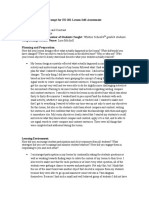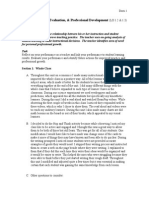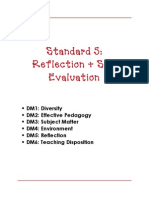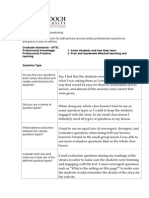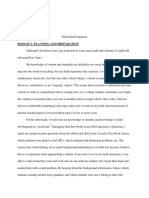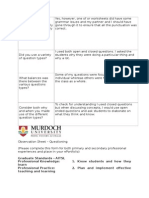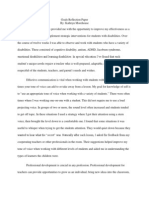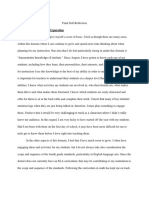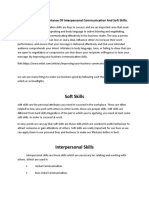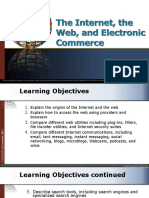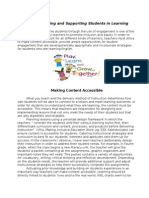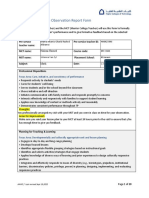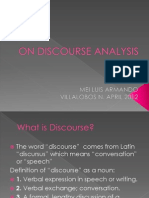0 ratings0% found this document useful (0 votes)
100 viewsTws 8
Tws 8
Uploaded by
api-236766479The teacher implemented hands-on activities in whole and small groups. During a lesson on snow, students discussed snow in pairs and took turns feeling and describing the snow. The teacher modified a lesson on rain gauges when she realized the measurements did not align to standards. She spent less time on winter due to students' prior knowledge and focused more on vocabulary which she identified as impacting test scores. The teacher used positive and negative reinforcement. Three students' performances are described: an absent middle student did well with one-on-one help; a low student struggled with frustration; a high student could have been given more advanced work. The teacher's goal is to better align lessons to standards and provide challenge for all students.
Copyright:
© All Rights Reserved
Available Formats
Download as DOCX, PDF, TXT or read online from Scribd
Tws 8
Tws 8
Uploaded by
api-2367664790 ratings0% found this document useful (0 votes)
100 views7 pagesThe teacher implemented hands-on activities in whole and small groups. During a lesson on snow, students discussed snow in pairs and took turns feeling and describing the snow. The teacher modified a lesson on rain gauges when she realized the measurements did not align to standards. She spent less time on winter due to students' prior knowledge and focused more on vocabulary which she identified as impacting test scores. The teacher used positive and negative reinforcement. Three students' performances are described: an absent middle student did well with one-on-one help; a low student struggled with frustration; a high student could have been given more advanced work. The teacher's goal is to better align lessons to standards and provide challenge for all students.
Original Title
tws 8
Copyright
© © All Rights Reserved
Available Formats
DOCX, PDF, TXT or read online from Scribd
Share this document
Did you find this document useful?
Is this content inappropriate?
The teacher implemented hands-on activities in whole and small groups. During a lesson on snow, students discussed snow in pairs and took turns feeling and describing the snow. The teacher modified a lesson on rain gauges when she realized the measurements did not align to standards. She spent less time on winter due to students' prior knowledge and focused more on vocabulary which she identified as impacting test scores. The teacher used positive and negative reinforcement. Three students' performances are described: an absent middle student did well with one-on-one help; a low student struggled with frustration; a high student could have been given more advanced work. The teacher's goal is to better align lessons to standards and provide challenge for all students.
Copyright:
© All Rights Reserved
Available Formats
Download as DOCX, PDF, TXT or read online from Scribd
Download as docx, pdf, or txt
0 ratings0% found this document useful (0 votes)
100 views7 pagesTws 8
Tws 8
Uploaded by
api-236766479The teacher implemented hands-on activities in whole and small groups. During a lesson on snow, students discussed snow in pairs and took turns feeling and describing the snow. The teacher modified a lesson on rain gauges when she realized the measurements did not align to standards. She spent less time on winter due to students' prior knowledge and focused more on vocabulary which she identified as impacting test scores. The teacher used positive and negative reinforcement. Three students' performances are described: an absent middle student did well with one-on-one help; a low student struggled with frustration; a high student could have been given more advanced work. The teacher's goal is to better align lessons to standards and provide challenge for all students.
Copyright:
© All Rights Reserved
Available Formats
Download as DOCX, PDF, TXT or read online from Scribd
Download as docx, pdf, or txt
You are on page 1of 7
TWS 8
Allison Taylor Lawrence
Whole Class Reflection
One of my instructional decisions was to use as much hands-on
whole group and small group activities as I could. I believe that
this impacted the social, behavioral, and summative
assessments of my whole class. Students were able to learn how
to communicate effectively as a group in order to learn the
objectives at hand. For example during one of my lessons I
paired students up into groups of two to discuss snow using their
senses. Students had to learn to take turns feeling the snow, and
listening to their partners observations. They formed two-way
discussions. One big modification I implemented was during a
lesson. I was teaching about rain gauges, in my lesson plan I
planed to have students make their own rain gauge. Although,
during instruction I discovered that the measurements that I
were using to teach them were not used in their standards. I had
to re-visit my lesson plan and adapt to a different measurement.
This allowed students to focus on what a rain gauge was and
what it was used for instead of how to make one.
In my long-range plan I determined that I would need to spend a
day on each season. Although based on the students responses
in whole-group discussion on winter, I concluded that they had a
vast amount of prior-information gained on this objective than I
expected. I determined that I should focus more on my other
objectives and spend less time on this objective. I also
determined that I could go into more depth with this topic by
addressing the affect each season has on animals, plants, and
human interactions. I thought that focusing more on vocabulary
would improve their test score, because after looking at the final
exam I determined vocabulary as a major part of the score.
I did a variety of motivation techniques. I did a lot of positive
reinforcement such as giving out candy to students who were on
task and answering questions thoughtfully. I was not focused
with correct answers during many of my pre-assessments
because much of the knowledge gained was new knowledge. I
focused instead on students participation. I tried negative
reinforcement for certain students by given students strikes for
disruptive behavior. I did however give students a chance always
to have a better day tomorrow.
I implemented all modes of instruction.
o Lecture: I did a KWL chart with them during a lecture to
monitor instructional gain
o Small group: I did many experiments in small groups such
as making thunderstorms with shaving cream and blue
food coloring, discovering snow with their senses, and
using fine arts skills when depicting the trees of each
season.
o Demonstration: I took students out on a school field trip
outside of another class to let them see what a
anemometer and a wind vane looked like. I demonstrated
how to draw them and label them, so that they could do
the same in their notebooks.
o Experiment: I did a lot of experimentation for this lesson.
We determined what rain sounded like, we determined
what seasons would feel like and why that was important.
My students were actively involved. Every lesson plan had some
form of movement, even formative assessments. I had students
up doing experiments, discussions (whole and small group), and
dancing or stretching during breaks between assessments.
Students were also involved actively using their minds. I made
sure that ever student got a chance to answer a question or give
a prediction for each lesson to make sure they were
understanding and following along.
I was able to relate a lot of the contents of the lesson plans to
the students lives. We discussed why recording temperature was
important to them. How weather would affect their activities
outside and what you could do differently in each season. We
discussed how dangerous weather affected them inside and
outside of the classroom.
Three (3) individual Students
Most successful: Middle Level Student-This students attendance
really played a huge factor in her performance. She was absent
at least once per-week. She is a very bright student, but it is hard
for anyone to keep up with make-up work and study for the
material that is being taught at the moment. Quantitative data
was up and down. She received a 70 and an 80 on objectives
three and four. I believe this is because she was absent and did
not get to turn in her work completed correctly, even with oneon-one assistance. Qualitative data shows a 100%, I believe this
is because when she is in school she is focused and ready to
learn. The one factor that intrigued me was she raised her pretest up by 43 points. I believe that my instructional planning
played a big part in this. Because she was not here all of the time
I was made a point work one-on-one with her almost everyday to
make sure that she was caught up and understood the content of
the lesson she missed. Also, because I worked one-on-one with
her I saw what areas she was struggling with most and was able
to adjust my original lesson plan to focus more attention on that
specific part of the lesson plan.
Least successful: Low-level Student- This student suffers from a
lot of emotional factors. Although, this is not under my control I
did implement many behavioral monitoring skills in the class. I
talked with him one-on-one and gave him smiles if he had a
positive day. He received a prize when he got a smiley face. I
believe his behavior played a big factor in his qualitative data.
He gets frustrated easily and gives up often, so his performance
and participation grades suffer. He received non-responsive on a
lot of objectives that were graded on discussion. Quantitative
data shows some of the same results, he did not complete his
work because he became frustrated and his grades showed him
giving up a lot of the time. One modification I would continue to
do for this student is more one-on-one reading. I believe if he
could read independently at a 2nd grade level his confidence
would improve and overall improving his performance. I did read
over some of his reading test with him, but had to stop due to
my cooperating teachers suggestion.
Average preforming Student: High-level Student: This student is
very skilled in all areas of instruction. He made an A average on
every part of the lessons objectives, relating to quantitative data.
Qualitative data he made a 100%. He received this grade
because I believe that it was instilled in him to care about his
grades, it shows in his focus and participation. The one factor
that I am still unsure about is why he dropped three points on his
final test than his pre-test. I believe that this might have been
because the format of review was different than he was originally
used to completing. I placed this student in the average
preforming section because I believe I could of done better
implementing more advanced instruction for him to grow more
as a learner. I also believe that I should of implemented more
peer based instruction so that he felt like he was able to share
his knowledge with other students in a positive environment.
One major modification: I believe that my many active
modification for my low-levels students behavior affected his
performance as well as the classs overall demeanor. Specifically
during my seasons lesson this student became infuriated with
me because I did not allow him to not draw his seasons in pencil.
I wanted him to show that he knew what each season would look
like using a variety of colors. He became verbally and physically
upset and as a result the class had to stop what they were doing.
Instead of reacting negatively to his behavior I asked to speak
with him outside of the class. I allowed him to draw in pencil, but
only for homework. I told him that I would put up his pictures on
my wall if he showed me he tried his best in color. This sparked
his interest in the lesson because he was being rewarded. As a
result the entire class tried their best to get their picture on my
wall.
Reflection on possibilities for Professional Development
Over this course I was introduced to the wonderful suggestion to
think about what I am teaching and why I am teaching it,
specifically based on standards. I never really sat down and
thought about what I wanted my students to gain after each part
of my lesson plans. I just focused on the end result. A goal for
me was to sit down with the standards and my lessons plans and
write out what I wanted from my students on each part of the
lesson. This opened my eyes up to why I teach and have my
students do certain activities in the classroom. I plan on
continuing to do this with my own lesson plans when I get my
own job. I also plan on sitting down with a high, middle, and low
level student and discussing with them what part of the lesson
was their favorite and why.
The second goal I am going to have for myself will be to have
options during instruction for the different ranges of students. I
struggled with adapting my lesson plans for my high level
learners. I did not give them an alternate assignment that was
more advanced to promote higher-level thinking till towards the
end of my experience. To help me achieve this goal I plan on
having more projects for this students, so that they can explore
a topic in detail and explore parts of a topic that interest them
the most.
You might also like
- Interview QuestionsDocument7 pagesInterview Questionsapi-311279304No ratings yet
- Example of CAS Log For IBDocument3 pagesExample of CAS Log For IBHadi AdiNo ratings yet
- Reflection WordDocument6 pagesReflection Wordapi-241359020No ratings yet
- Observation Sheet SecondayDocument9 pagesObservation Sheet Secondayapi-294975120No ratings yet
- Observation Sheet - SecondaryDocument6 pagesObservation Sheet - Secondaryapi-263496207No ratings yet
- Observation Sheet - ManagementDocument8 pagesObservation Sheet - Managementapi-328833941No ratings yet
- Promptfored 201 Lessonselffa 09Document2 pagesPromptfored 201 Lessonselffa 09api-296442187No ratings yet
- Self Assessment For Observed LessonDocument2 pagesSelf Assessment For Observed Lessonapi-241168263No ratings yet
- MDD 5Document4 pagesMDD 5api-224695265No ratings yet
- Observed Lesson Self-AssessmentDocument4 pagesObserved Lesson Self-Assessmentapi-305785129No ratings yet
- Primary School Observation SheetDocument8 pagesPrimary School Observation Sheetapi-295266220No ratings yet
- Primary EvaluationDocument10 pagesPrimary Evaluationapi-294975120No ratings yet
- Observation Sheet-PrimaryDocument12 pagesObservation Sheet-Primaryapi-294890109No ratings yet
- Tws 8 DornDocument4 pagesTws 8 Dornapi-176703960No ratings yet
- Feedback - Whole Class:: Chelsea Schmieding EDUC 461 - Student Teaching TWS #7 - Instructional Decision MakingDocument2 pagesFeedback - Whole Class:: Chelsea Schmieding EDUC 461 - Student Teaching TWS #7 - Instructional Decision Makingapi-242380700No ratings yet
- Tws 8 429 NewDocument11 pagesTws 8 429 Newapi-246132572No ratings yet
- Learning Guide Part 2Document11 pagesLearning Guide Part 2api-263112128100% (1)
- Week 1 Reflection 9-26-14Document3 pagesWeek 1 Reflection 9-26-14api-263459309No ratings yet
- Observed Lesson Self AssessDocument3 pagesObserved Lesson Self Assessapi-252901681No ratings yet
- Reflection On Lessons Ginna WeatherfordDocument7 pagesReflection On Lessons Ginna Weatherfordapi-212499894No ratings yet
- Professional Experience Reflection SecondaryDocument10 pagesProfessional Experience Reflection Secondaryapi-295087972No ratings yet
- Edr - Reflection OrtegaDocument3 pagesEdr - Reflection Ortegaapi-457493836No ratings yet
- Final Reflection Edr 318Document3 pagesFinal Reflection Edr 318api-405564093No ratings yet
- Reflection For Lesson-ClDocument2 pagesReflection For Lesson-Clapi-249238099No ratings yet
- Tws ReflectionDocument4 pagesTws Reflectionapi-274380061No ratings yet
- Goals Reflection EssayDocument4 pagesGoals Reflection Essayapi-246277065No ratings yet
- Standard 5 FinalDocument7 pagesStandard 5 Finalapi-252417954No ratings yet
- Tws 8 Reflection Mary CatherineDocument3 pagesTws 8 Reflection Mary Catherineapi-176703960No ratings yet
- Observations PrimaryDocument12 pagesObservations Primaryapi-294926661No ratings yet
- Second Observed Lesson Self AssessmentDocument5 pagesSecond Observed Lesson Self Assessmentapi-334958359No ratings yet
- Self Asessment Lesson 4Document3 pagesSelf Asessment Lesson 4api-267446628No ratings yet
- Observation SecondaryDocument12 pagesObservation Secondaryapi-294960766No ratings yet
- ReflectionDocument8 pagesReflectionapi-314167656No ratings yet
- Observation Sheet-SecondaryDocument12 pagesObservation Sheet-Secondaryapi-294890109No ratings yet
- Tws 8 FinalDocument3 pagesTws 8 Finalapi-235236994No ratings yet
- Final Self-EvaluationDocument6 pagesFinal Self-Evaluationapi-403659656No ratings yet
- Teaching Artifact 1Document2 pagesTeaching Artifact 1api-355609846No ratings yet
- Educ 450 OverallreflectioncritiqueDocument3 pagesEduc 450 Overallreflectioncritiqueapi-282071507No ratings yet
- Observation SheetDocument11 pagesObservation Sheetapi-283943860No ratings yet
- Reflection and Self EvalDocument5 pagesReflection and Self Evalapi-234812755No ratings yet
- Inquiry Part 4 Level 3Document18 pagesInquiry Part 4 Level 3api-700816149No ratings yet
- Practicum Reflection - Brianna RattrayDocument7 pagesPracticum Reflection - Brianna Rattrayapi-249598813No ratings yet
- Student Teaching Reflection Katie MorehouseDocument5 pagesStudent Teaching Reflection Katie Morehouseapi-250709386No ratings yet
- School Experience Reflection Journal 2Document6 pagesSchool Experience Reflection Journal 2api-272317458No ratings yet
- Four Levels of ReflectionDocument4 pagesFour Levels of ReflectionAmirah Izzati Nor AzamNo ratings yet
- Introduce Yourself / Tell Something About YourselfDocument21 pagesIntroduce Yourself / Tell Something About YourselfJespher GarciaNo ratings yet
- PostobservationreflectionDocument2 pagesPostobservationreflectionapi-356058423No ratings yet
- PostobservationreflectionDocument3 pagesPostobservationreflectionapi-300691216No ratings yet
- Professional Growth Plan - Part 2Document19 pagesProfessional Growth Plan - Part 2api-457318255No ratings yet
- Britney Jonda Reflection SumDocument9 pagesBritney Jonda Reflection Sumapi-604941348No ratings yet
- MicroteachDocument9 pagesMicroteachapi-457318255No ratings yet
- Tutoring Reflection I and IIDocument4 pagesTutoring Reflection I and IIapi-353333850No ratings yet
- Reflection Section 1Document4 pagesReflection Section 1api-532082117No ratings yet
- Experiencing The Teaching-Learning Process: Episode 3: Assisting A Teacher With A "Teacher's Toolbox"Document5 pagesExperiencing The Teaching-Learning Process: Episode 3: Assisting A Teacher With A "Teacher's Toolbox"Ananias CatanguiNo ratings yet
- Tws 6Document6 pagesTws 6api-185932738No ratings yet
- tws8 KcruellDocument3 pagestws8 Kcruellapi-200994898No ratings yet
- MDD 5 - 6Document15 pagesMDD 5 - 6api-300454982No ratings yet
- Observation SheetDocument13 pagesObservation Sheetapi-263589893No ratings yet
- Final ReflectionDocument9 pagesFinal Reflectionapi-376373807No ratings yet
- Bed 150 Observation List PrimaryDocument12 pagesBed 150 Observation List Primaryapi-330260924No ratings yet
- 50 Ways to Be a Better Teacher: Professional Development TechniquesFrom Everand50 Ways to Be a Better Teacher: Professional Development TechniquesRating: 4 out of 5 stars4/5 (9)
- Tws 4Document30 pagesTws 4api-236766479No ratings yet
- Tws 3Document4 pagesTws 3api-236766479No ratings yet
- Tws 2Document4 pagesTws 2api-236766479No ratings yet
- Tws 1Document12 pagesTws 1api-236766479No ratings yet
- Tws 4 Lesson Plan 4Document14 pagesTws 4 Lesson Plan 4api-236766479No ratings yet
- Tws 6Document8 pagesTws 6api-236766479No ratings yet
- Formal Lesson Plan 4 Weather UnitDocument5 pagesFormal Lesson Plan 4 Weather Unitapi-236766479No ratings yet
- Tws 4 Lesson Plan 3Document7 pagesTws 4 Lesson Plan 3api-236766479No ratings yet
- Photo Permission FormDocument1 pagePhoto Permission Formapi-236766479No ratings yet
- Tws 6 FinalDocument14 pagesTws 6 Finalapi-236766479No ratings yet
- Lesson 6 12oc-Ibe-8Document3 pagesLesson 6 12oc-Ibe-8Francis A SalvadorNo ratings yet
- Edf 5903 - Reference - Jati 25570633Document2 pagesEdf 5903 - Reference - Jati 25570633api-266205329No ratings yet
- Ruxandra Coman - Examen EnglezaDocument6 pagesRuxandra Coman - Examen EnglezaMihail CurelescuNo ratings yet
- Example On Kano AnalysisDocument5 pagesExample On Kano AnalysisJheremy Peñaflor GutangNo ratings yet
- Functions of Learner Output in Language PDFDocument15 pagesFunctions of Learner Output in Language PDFMARIA DEL CARMEN ALVARADO ACEVEDONo ratings yet
- Appendix A - Communication Plan Template !!!Document2 pagesAppendix A - Communication Plan Template !!!teamromejamunaNo ratings yet
- DIAZ COLLEGE - PrelimDocument5 pagesDIAZ COLLEGE - PrelimKhim KimNo ratings yet
- The Power of Language - How Words Shape People, CultureDocument8 pagesThe Power of Language - How Words Shape People, CultureludipovaNo ratings yet
- Atoll A Radio Planning and OptimizationDocument49 pagesAtoll A Radio Planning and OptimizationoppaNo ratings yet
- Consumer Behavior and TechnologyDocument34 pagesConsumer Behavior and Technologyutkarsh tripathiNo ratings yet
- Soft Skills: Explaining The Importance of Interpersonal Communication and Soft SkillsDocument4 pagesSoft Skills: Explaining The Importance of Interpersonal Communication and Soft SkillsTech InfoNo ratings yet
- Emotional Intelligence PresentationDocument31 pagesEmotional Intelligence Presentationsweety100% (2)
- Webinar MasteryDocument3 pagesWebinar MasteryPeterpejaviNo ratings yet
- Lesson Plan 1-5-2018Document2 pagesLesson Plan 1-5-2018Amiga MiNo ratings yet
- Chapter 7 - The InternetDocument41 pagesChapter 7 - The Internetrani aliasNo ratings yet
- Makalah Teater and DramaDocument15 pagesMakalah Teater and Dramamaya 1021No ratings yet
- Essay 2Document8 pagesEssay 2api-285027832No ratings yet
- EDITORIALDocument4 pagesEDITORIALlorennavNo ratings yet
- Auditing Routers, Switches, and FirewallsDocument14 pagesAuditing Routers, Switches, and FirewallsTrafalgar S Topan0% (1)
- MCT Report 1 MahraDocument4 pagesMCT Report 1 Mahramahra alshamsiNo ratings yet
- Research Paper: The Effectiveness of Group Discussion Techniques in Language Teaching, in The Class RoomDocument14 pagesResearch Paper: The Effectiveness of Group Discussion Techniques in Language Teaching, in The Class RoomEni WidiantiNo ratings yet
- Teaching Reading and WritingDocument33 pagesTeaching Reading and WritingJESSICA ROSETE50% (2)
- 5G CommandDocument2 pages5G CommandJunaid100% (2)
- Case Study of Haldiram: by - Rishav Tomar Yash Choudhary Chirag Trivedi Vanshika AnjalikaDocument8 pagesCase Study of Haldiram: by - Rishav Tomar Yash Choudhary Chirag Trivedi Vanshika AnjalikaRishav TomarNo ratings yet
- On Discourse AnalysisDocument14 pagesOn Discourse AnalysisArmandouaaNo ratings yet
- Abdul Snapchat11Document10 pagesAbdul Snapchat11api-356399914No ratings yet
- BBA 6 Sem Solved AssignmentDocument12 pagesBBA 6 Sem Solved Assignment23980hcasdjknNo ratings yet
- Chapter 4Document3 pagesChapter 4Catherine PalangdaoNo ratings yet
- Biography Presentation Lesson Plan: ObjectivesDocument7 pagesBiography Presentation Lesson Plan: ObjectivesLuisNo ratings yet









